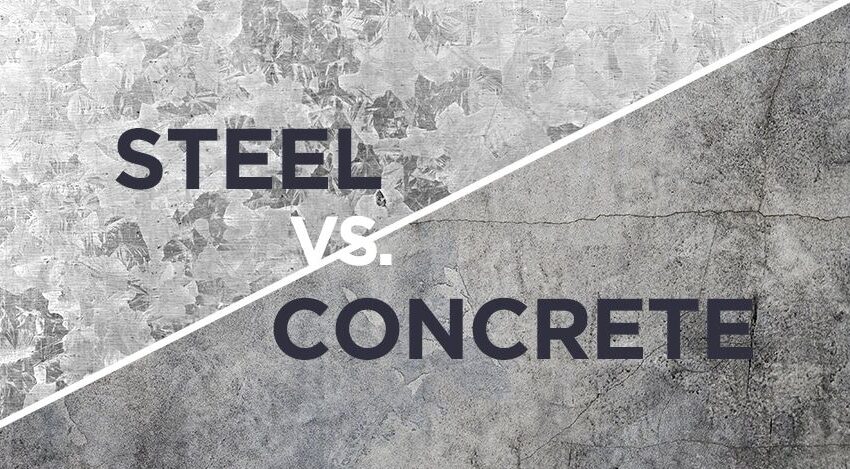A bunker is essential for people to keep themselves safe when disaster strikes. Hurricanes, tornadoes and biological attacks make typical housing vulnerable, so finding a shelter made with quality materials is vital for survival.
When building a bunker, consumers find themselves deciding between concrete and steel. Which option is the best for a shelter? This guide outlines the pros and cons of each and discusses how they can pair together.
What Are the Pros of Steel Bunkers?
Steel is preferred for bunkers because it provides the strength needed for maximum protection. These three pros demonstrate why steel is the superior choice.
Lightweight Durability
The advantages of steel bunkers start with their weight. These shelters are lighter than concrete bunkers, making installing them more manageable. Plus, bunker owners may need to transport their facility to various locations. Lightweight shelters made from steel are much easier to transport if they’re above ground.
Lightweight shelters may make some customers think of compromised durability. However, steel bunkers last a long time. Treating steel with a 150-year rubber coating strengthens steel shelters and ensures minimal maintenance is necessary.
Water Resistance
Moisture is a significant issue regarding bunkers. Over time, rain can compromise a facility by corroding the building materials, leading to leaks, mold and mildew. Steel has the upper hand with water resistance because it’s non-porous, meaning water has difficulty penetrating the metal’s surface.
While steel is strong on its own, bunker owners can make their bunkers even better with galvanized steel. This metal is even stronger in protecting against tornadoes, earthquakes and heavy rain. The auto industry uses galvanized steel for efficiency and synthesis, and the same pros apply to bunkers. Galvanized steel makes shelters more resistant to fire and rust, ensuring the facility’s long-term use.
Flexibility
Homeowners may differ in their needs for bunkers, so steel is the ideal choice for those who need flexibility. Steel contraptions are easier to customize for any needs. For example, people with disabilities may need unique accommodations to fit their needs. They’ll have an easier time customizing their shelter with steel.
Steel is also terrific for bunker owners who want to upgrade. Once the shelter is in place, the facility owner can easily modify it to adapt to any needs. For example, a family may expand the facility to include more people. A community bunker may want to upgrade its tech features around the space. Steel makes customization easier.
What Are the Cons of Steel Bunkers?
Steel bunkers are excellent choices for customers wanting to construct a shelter. However, they do have some cons people should consider.
Expensive
The primary downside to steel bunkers is their cost. They’re more expensive than concrete facilities, creating a roadblock for the average consumer wanting to construct a storm shelter. So, why are steel bunkers more expensive?
The high costs start with the production and installation. Steel shelters have terrific strength and water resistance, but the high quality comes at a price. Production is more expensive because it requires more specialized materials than a typical concrete bunker. Plus, installation is more difficult because they may require welding machines, cranes and other advanced equipment.
Insulation
Insulation is another drawback of steel bunkers compared to concrete. Steel is a solid heat conductor, helping ovens, boilers and kitchen appliances when heating. However, it’s not always apt for a shelter.
Some situations may force people inside a bunker for days or weeks. In 2005, the U.S. Army needed over a month to eliminate Hurricane Katrina’s floodwaters from New Orleans. It can quickly get stuffy and uncomfortable inside an above-ground shelter during this time. Steel is thinner than concrete, making those inside more susceptible to the weather conditions outside. These shelters require excellent insulation systems to remain safe in the long term.
Steel shelters are best underground because they’ll have ambient temperatures. However, bunker owners can install air conditioning and heaters to increase comfort levels.
Noise
The thinner walls make steel a liability for temperature and noise. Inside the shelter, noise from people and machines will reflect off the walls. The inhabitants may have difficulty concentrating on the tasks ahead of them if they can’t think straight. Compromised communication and sleep lead to more problems besides the disaster itself.
Bunker owners can make modifications if necessary. Installing soundproofing materials like fiberglass or foam makes the steel shelter much better at absorbing sound than reflecting it. Installing steel bunkers underground also assists in decreasing noise levels.
What Are the Pros of Concrete Bunkers?
Concrete is another option for bunker customers. While steel is often the superior material, concrete does have some advantages. Here are three pros of building a concrete shelter.
Affordability
The first advantage is cost. Concrete bunkers tend to be cheaper because the materials are less expensive. Concrete requires cement, water and various aggregates for bunker construction. Bunker customers also get more price stability with concrete compared to steel. The last few years have seen volatile steel prices, leading to higher shelter costs.
Concrete can also be beneficial based on local availability. The average consumer has easier access to a local concrete producer than steel. Metal facilities may require transportation across long distances before building.
Weight
Concrete tends to be heavier than steel, which has pros and cons. The advantages of a heavyweight shelter include increased blast resistance. Concrete does an excellent job of absorbing shock waves and reducing the impact people feel inside the shelter.
Shelters using concrete contain cement similar to what people drive on the road. Cement is durable and lasts long despite heavy traffic, making it an excellent material for building a storm shelter. Bombs or other explosives have more difficulty penetrating concrete walls, making it a workable option for a shelter.
Easy Installation
Concrete bunkers are typically cheaper because of the materials and the installation. The bunker architect can mold the concrete on-site, whereas steel parts are usually manufactured in an off-site facility and brought to the bunker’s location. Transportation is more manageable, making the costs lower. The shelter builders also have more flexibility when designing the bunker because it’s easier to customize. Steel may require cutting and welding to achieve the desired outcomes.
What Are the Cons of Concrete Bunkers?
While they have some advantages, concrete bunkers have a few drawbacks that consumers should consider.
Weaker Infrastructure
Concrete is strong, but it does suffer from brittleness. Brittle concrete has lower tensile strength, making it less flexible under stress. The shelter will begin to crack if there is too much pressure. Concrete’s toughness is better for compressive strength, leading many construction teams to use it for beams and columns.
However, its tensile strength is typically insufficient to be a long-lasting solution for bunkers. If debris starts flying through the air, concrete shelters will only hold up for so long.
Moisture
High-quality storm shelters must protect the people inside from torrential rain. Unfortunately, concrete bunkers don’t hold up as well as steel facilities. Concrete is vulnerable to moisture whenever it rains. It’s far more porous than steel, allowing water to seep inside. The moisture causes the cement to crack, thus risking collapse for the entire bunker. In this situation, the shelter becomes more of a liability than a safety measure.
Concrete bunker owners can mitigate the damage by using waterproof materials. For example, they can use epoxy, bitumen or polyurethane to seal cracks in the concrete and make it stronger. They can make it easier to maintain a concrete shelter over the years.
Environmental Concerns
Sustainability is a significant concern for many customers, extending to underground bunkers. Concrete and steel production have environmental impacts that are worth considering before purchasing a bunker. The exact carbon footprint of each depends on the transportation used and the manufacturing process. However, concrete production tends to be worse for the planet.
Cement production leads to heavy amounts of toxic substances released into the environment. These substances, such as sulfur dioxide and carbon monoxide, can cause respiratory issues in people. Plus, concrete also has a negative reputation for its carbon dioxide (CO2) emissions. The energy-intensive process might not be a great selection for the environmentally conscious.
Can Bunkers Use Steel and Concrete?
Bunker customers typically pick between steel and concrete, but they can use both materials. Concrete generally is not recommended as a bunker material on its own. However, covering steel bunkers with concrete is an excellent way to get the best of both worlds. Concrete encasements add durability and longevity by insulating the steel and protecting the metal from blasts.
Choosing Between Concrete and Steel Bunkers
Building a bunker is an excellent choice to protect families and communities from disaster. Storm shelters provide much flexibility in design, allowing customers to determine the facility’s materials, size and amenities.
Steel and concrete are among the most popular options for bunkers, with steel being the better choice. Concrete is best as extra protection when combined with steel. Leaving concrete as the only safeguard against explosions and weather is not recommended.


